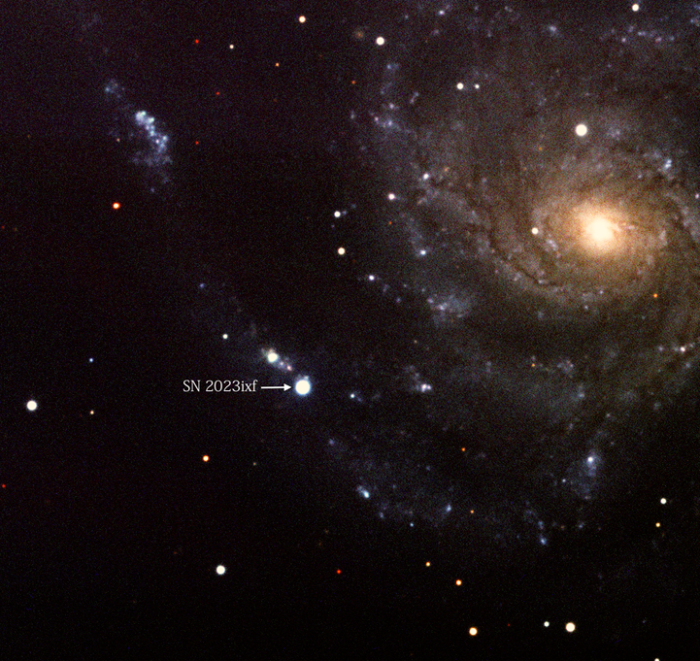By studying the once-in-a-decade supernova SN 2023ixf, a research team led by Dr. Jujia Zhang of the Chinese Academy of Sciences and Prof. Xiaofeng Wang of Tsinghua University discovered the stellar mass forcibly expelled from the progenitor near the conclusion of its existence. Such mass loss mechanisms can give critical information for understanding a large star’s ultimate phase.

SN 2023ixf and its host galaxy. Image Credit: Yunnan Observatories
Science Bulletin published the findings on September 14th, 2024.
Type II supernovae (SNe II) are the most common stellar explosions in the Universe, and the last stage of evolution of their hydrogen-rich massive progenitors toward core-collapse explosion remains a mystery. The last stage of development, as well as the resulting circumstellar conditions, have resulted in a wide range of such explosions.
Capturing the first-light signals of the SN explosions, or the flashed spectra, caused by the ionization of the circumstellar material (CSM)/stellar wind by ultraviolet/high energy photons from shock breakout cooling, is required to establish a connection between the explosion of SNe II and the late-time evolution of massive stars.
The recent explosion of SN 2023ixf in the neighboring galaxy Messier 101 offers a once-in-a-lifetime chance to address this persistent problem. The parameters of the circumstellar material around this supernova can be tightly constrained by timely, high-cadence flash spectra collected within 1–5 days following the explosion.
The progenitor of SN 2023ixf is thought to have shed material at a mass-loss rate of 6×10–4 M⊙ yr–1 in the final 2–3 years before the explosion. A compact CSM shell formed from surrounding material that was traveling at a speed of 55 km s–1 and within a radius of less than 7×1014 cm of the progenitor.
The progenitor of SN 2023ixf could have been a short-lived yellow hypergiant that changed from a red supergiant just before the explosion, according to the high mass-loss rate, relatively high wind velocity, and pre-explosion data collected roughly 20 years ago.
The observation and investigation of SN 2023ixf is ongoing. A series of works on this SN will make it a milestone in the history of SNe II and will then help to reveal the fate of massive stars in the mass range from 10 to 20 M⊙.
Dr. Jujia Zhang, Yunnan Observatories, Chinese Academy of Sciences
Journal Reference
Zhang, J., et al. (2023) Circumstellar material ejected violently by a massive star immediately before its death. Science Bulletin. doi:10.1016/j.scib.2023.09.015